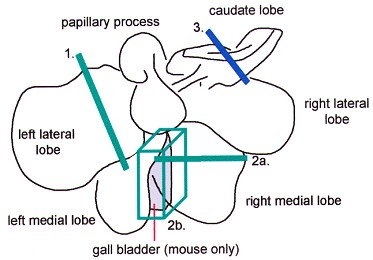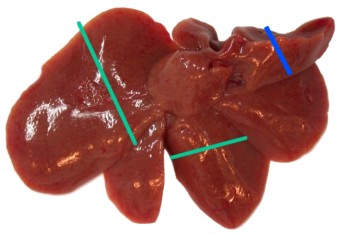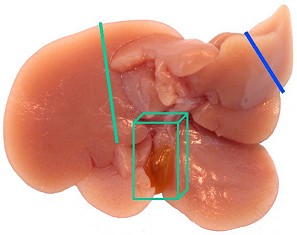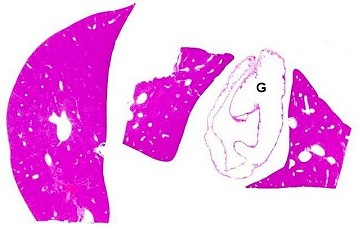
Liver, visceral aspect, indicating the cut levels for rats and mice.
| Species: | Rats and Mice |
| Organs: | Liver Gall bladder (mouse only) |
| Localizations: | 1) Left lateral lobe 2a) Rat: right medial lobe 2b) Mouse: left and right medial lobe including gall bladder 3) Optional: caudate lobe |
| Number of sections: | 2 (3) |
| Direction: | 1, 2a, 3) Transverse, 2b) longitudinal-vertical |
| Remarks: | Sample sizes should be as large as possible but can be adapted so that all pieces fit into one cassette. For identification purposes, standardized shaping of one of the larger lobes can be performed. Sampling from other locations is also appropriate, if consistency is provided. |
 Liver, visceral aspect, indicating the cut levels for rats and mice. |
 Rat liver, visceral aspect. |
 Mouse liver, visceral aspect, with gall bladder. |
 Mouse: liver and gall bladder (G), sections 1 and 2b. |
If major bile duct is required, the optimal section is the one through the left lateral lobe.
Relevant differences between rats and mice
Gall bladder in mice: the longitudinal section is preferred to the transverse one. In the longitudinal section, the gall bladder will be in anatomical conjunction with the liver lobes, whereas in the transverse section, the slice of the gall bladder is prone to lose its connection to the liver tissue.
See also:
Introduction
|
Trm V 5.00 |
Reference: Ruehl-Fehlert C, Kittel B, Morawietz G, et al. (2003) Revised guides for organ sampling and trimming in rats and mice – Part 1. A joint publication of the RITA and NACAD groups. Exp Toxic Pathol 55: 91–106 |